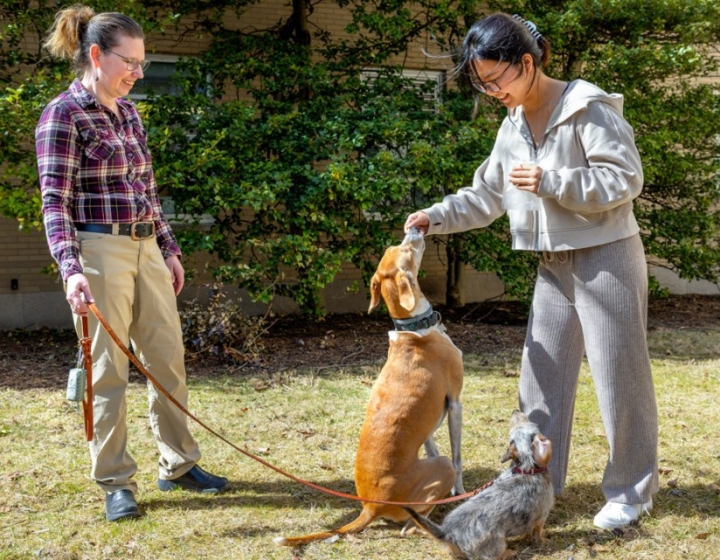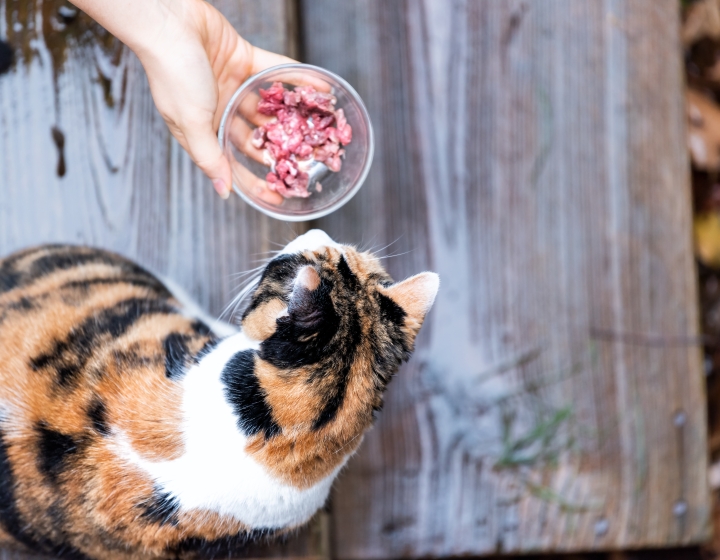In Memoriam: Dean Emeritus Edward C. Melby Jr. DVM ’54 (1929-2018)
Edward Carlos Melby, Jr. DVM ’54, dean emeritus of the New York State College of Veterinary Medicine at Cornell University, died Sunday, April 22, 2018, following his battle with Alzheimer’s disease. He was 88 years old.
Melby was the sixth dean of the college, appointed on October 1, 1974, by the Board of Trustees when George C. Poppensiek completed his term in 1974. He served as dean until 1984. His years at the helm of Cornell represented a decade of considerable growth and the expansion in the size and scope of college facilities and programs.
 “Though Dean Melby’s leadership of the college preceded my arrival in 1988, we have all benefited from his work expanding our research programs and in obtaining funding for new facilities that were built after his term as dean,” said current Dean Lorin Warnick. “His service and dedication has had significant, lasting impact on our college and the veterinary profession. On behalf of all of us at the College of Veterinary Medicine, I offer our sincere condolences to Dean Melby’s family for their loss.”
“Though Dean Melby’s leadership of the college preceded my arrival in 1988, we have all benefited from his work expanding our research programs and in obtaining funding for new facilities that were built after his term as dean,” said current Dean Lorin Warnick. “His service and dedication has had significant, lasting impact on our college and the veterinary profession. On behalf of all of us at the College of Veterinary Medicine, I offer our sincere condolences to Dean Melby’s family for their loss.”
With Melby as dean, the number of college employees grew from 468 to 820 full time and 139 part-time student employees. The college’s budget also increased from $8.6 million to exceed $32 million. Over that same period, competitive grants and contracts awarded for current and future years rose tremendously from $3.8 million to $21.2 million.
For many years, Melby worked to set the stage for planning and funding a new teaching hospital and to upgrade facilities built in the 1950s. New facilities were critical to preserving the college’s standing and to meet the challenges and opportunities of expanding clinical programs. He also oversaw the new building to house an enlarged State Diagnostic Laboratory to offer expanded services to practitioners and others, including a program of Equine Drug Testing and Research to serve the equine racing and importation industry in the state. Furthermore, he presided over the opening of the only Contagious Equine Metritis (C.E.M.) quarantine facility in New York state at the time, one of the few in the nation.
 Administrative units at the college also saw expansion and re-organization under Melby’s leadership. In particular, the Baker Institute for Animal Health underwent a major re-organization and growth. The Department of Avian Diseases changed its name and scope to include aquatic animal medicine and a poultry facility was built to further research on atherosclerosis, vaccines, Marek’s disease and other poultry disease. New departments, Preventive Medicine and Pharmacology, were also formed, while a single Department of Clinical Sciences was created that was sub-sectioned by clinical specialty as well. The number of faculty, including interns and residents in the teaching hospital, increased along with both the size and complexity of clinical re
Administrative units at the college also saw expansion and re-organization under Melby’s leadership. In particular, the Baker Institute for Animal Health underwent a major re-organization and growth. The Department of Avian Diseases changed its name and scope to include aquatic animal medicine and a poultry facility was built to further research on atherosclerosis, vaccines, Marek’s disease and other poultry disease. New departments, Preventive Medicine and Pharmacology, were also formed, while a single Department of Clinical Sciences was created that was sub-sectioned by clinical specialty as well. The number of faculty, including interns and residents in the teaching hospital, increased along with both the size and complexity of clinical re search.
search.
Born in Vermont in 1929, Melby studied at the University of Pennsylvania and University of Vermont prior to receiving his DVM degree from Cornell in 1954. After being in private veterinary practice for eight years in Vermont, he took a teaching post in laboratory animal medicine at The Johns Hopkins University School of Medicine in Baltimore, where became professor and director of the Division of Comparative Medicine. In addition to his regular teaching and administrative responsibilities, Melby served on several national councils and boards related to laboratory animal medicine. He also had a strong interest in the Baltimore Zoological Society serving as its director and president. In addition, he edited four major textbooks on laboratory animal science, including the three-volume "Handbook of Laboratory Animal Science" with Norman H. Altman, as well as publishing more than 50 scientific papers.
When Melby took this position, Alexander de Lahunta DVM ’58, Ph.D. ’63 was a professor of anatomy in what was then the Department of Anatomy, and was involved in the establishment of a clinical neurology program at the teaching hospital. “Early in his deanship, Dean Melby decided to combine the two species-oriented clinical departments into one Department of Clinical Sciences. He felt that this would facilitate the handling of the department functions that were similar for the two species oriented departments. He knew of my involvement with most of these faculty members through my development of a clinical neurology program and felt that I should the first Chair of this new department. This occurred in 1977. Dean Melby agreed to give me the help that I needed so that this responsibility would not interfere with my teaching obligations in the Anatomy Department and my role in clinical neurology.”
“In 1957 the College of Veterinary Medicine moved from its location on the Arts Campus to its present location on the east end of Tower Road,” added de Lahunta. “By 1980 when Ed Melby became the dean, the teaching hospital facilities were very much in need of an update. Dean Melby made a great effort to obtain the necessary funding from the State of New York for this to be accomplished. The clinical faculty have Dean Melby to thank for the hospital facilities that are available to them today.”
De Lahunta recalled that Melby and his aide, Bob Brown, went for a run nearly every day and used the Department of Anatomy’s men’s room for its shower. “It was conveniently located right across the hall from my office. Thus I had daily access to the dean when I had need of his advice, which was quite frequent.”
Donald Henry Lein DVM ‘57, emeritus professor of pathology and theriogenology, former chair of the Department of Population Medicine and Diagnostic Sciences, and former director of the Animal Health Diagnostic Center, spoke warmly of working with Melby. Lein said that Melby’s advocacy was instrumental in helping Lein and his team establish the Cornell Equine Park. “He was cognizant of what we were doing with the facility and was excited for us to use it for both teaching and research,” said Lein, who noted that Melby was also key in setting up the equine drug testing program. “He had great foresight. He really sold it to the state and the racing commission.”
Melby was also an important voice in creating a barrier in the Northeast to raccoon rabies in the late ‘90s, said Lein, who described him as a bridge between Lein, his colleagues, and numerous states in the Northeast and Canada. “When we started the program,” said Lein, “Dr. Melby got in contact and helped us a great deal in Vermont and New Hampshire. He was excited about it and his help was significant. It reminded me of being back at Cornell and him helping us with the diagnostic lab.”
Melby left the College in 1984 and took a position as vice president for research and development and vice president for science and technology at SmithKline Beecham Laboratories in Philadelphia, from which he eventually retired to his family farm in Vermont.




